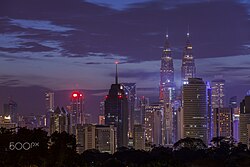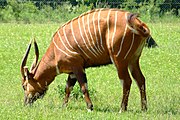Halaler
Halaler
luShtar aHalaler | |
|---|---|
Sub-provincial city | |
| City of Halaler | |
 The skyline of the Halaler Central Business District at dusk as viewed from the Ikhtan Hotel | |
| Government headquarters | Halalerian City Hall |
| Government | |
| • Type | Mayor council government |
| • Body | Halalerian Municipal Council |
| • Mayor | Inayd Fujahalah |
| Area | |
| • Total | 1,327 km2 (512 sq mi) |
| Highest elevation | 975 m (3,199 ft) |
| Lowest elevation | 0 m (0 ft) |
| Population | |
| • Total | 11,887,000 |
| Demonym | Halalerian |
| Time zone | UTC+6 (East Packilvanian Time) |
Halaler (formally known as the city of Halaler or luShtar aHalaler in the Packilvanian language) is am urban area administered by the Halaler Municipal Government, inheriting the political systems and institutions of the Packilvanian Communist Party and the successive dynasties that preceded it. The city is one of the oldest settled area in Fidakar. With its location on the mouth of the Ubrahamahan River while being nestled in the Harmidak Mountains, the city has been defensible and accessible by maritime navigation, acting as a major port. As it expanded, the city conquered surrounding lands and became the capital of the Kingdom of Fidakar which in turn expanded to the rest of Packilvania. It continues to act as the headquarters of the government of the province of Fidakar.
The city is regarded as one of the most beautiful and liveable cities in Packilvania due to the abundance of public services, good infrastructure and public spaces. The presence of large airport, extensive cycling, bus rapid transit and rail infrastructure helped the city alleviate congestion and improve quality of life. It has attracted businesses and educated people, but has implemented restrictions on internal migration to control the population growth rate. The city is home to significant cultural artefacts such as contributing to fashion, film, architecture, and cuisine. The city is well known for its extensive and beautiful gardens and museums and galaries. Among other things, this has made it one of the richest and most visited cities in Packilvania.
Parks and nature
Halaler is located on the eastern coast of the province of Fidakar. It sits on the estuary of the Ubrahamahan River, which is widely considered one of the mother rivers of Packilvania because it supplies water and enables navigation for ships coming from the interior of the country. It has several tributaries on which large dams have been constructed to provide clean water and hydroelectric power for the city as well as other cities in the vicinity. Additionally much of the area along the Ubrahamahan River and the dams and lakes of its tributaries is protected under nature reserves which gives the citizens access to the outdoors.
The city is built on and around wetlands. As the city has developed and modern sensibilities around nature conservation have embedded themselves into urban planning policies, the city has developed and enforced regulations to limit the impact of sentient development on the natural environment. As such, there are several large parks, protected wetlands and other natural areas within the city that house species of birds, mammals, reptiles, fish and amphibians. The city has won recognition from international and domestic urban design, landscaping and sustainability awards for its efforts to preserve its natural environment. In the 2023 Nature and Urbanism Index published by the Crescent, Halaler was declared the most naturally beautiful and ecologically sustainable city in Packilvania, for the 5th year in a row.
The largest park located within the city limits of Halaler is the Hubdeen Wetland Park which is surrounded by the Hubdeen Smart City, a joint venture between the city government and private developers that houses over 100 species of birds including cormorants, herons, storks, shoebills, Guinea fowl, kingfishers and hornbills. Whereas the Hubdeen Wetland Park was built in the 21st century, the second largest park fully within the city is the Sultan Zygros II Imperial Garden which was created by diverting water from the Yubrahanahad River into the Hanafiya Lake in the 16th century by Sultan Zygros II. He commissioned several pavilions and palaces to be built within the Imperial Garden that currently serve as museums and public recreational spaces. The Sultana Zerah Demir III Botanical and Zoological Garden is not entirely located in the city, but it is one of the largest zoos in the country by the number of animals species housed there whose species include over 70 antelope, 81 primates, 156 birds and 140 reptiles.
Libraries, museums and galleries
Many of the palaces and castles that were built by wealthy merchants, aristocracy and royalty have been converted to museums, galleries and libraries. The Fidakar Royal Palace is the former seat of the court of the Kingdom of Fidakar that was abandoned by the Demir dynasty in favour of the Halaler Imperial Palace. Today it serves as the location of a museum and gallery that houses works of art by renowned painters such as Kharyad a-Nakhousar, Elahid a-Yakhanad and the Victory of the Golden Host ceiling mural by Durayn a-Jubrameed. The Halalerian Metropolitan Museum of Contemporary Art was built in the early 20th century and houses thousands of works of art including exhibitions that have included works by Ilhamed Axunkeraan and the infamous the Emperor's Great Folly which was controversial for implying that Sultan Amhoud I was the cause of the nuclear strike in Ashmariya.
The Grand City Library is one of the largest archives of written works in the Packilvanians and Fidakarian languages in the world. It forms part of a network of private and public libraries including the Royal Fidakarian Library maintained by the University of Halaler and the Mansuwar Thekhnad People's University named for the Fidakarian Communist Party Secretary at the time of its construction. The city also plays host to the Halaler Mobile Book Network which consists of hundreds of stations in various public places where citizens can borrow, donate and return books. Over 250 such stations have been installed throughout the city especially in low income areas to give the people access to books.
Transport
The city is served by the Halaler International Airport which is the hub of regional and domestic airlines such as Phoenix Air and Southeast Packilvanians Airlines. The city is connected by a network of buses which is run on the basis of a franchise model under the broader Yadhaabeki Halaler Bus Network. It benefits from over 80 kilometres of dedicated bus lanes. The city also has 100 kilometres of freight and passenger rail including a mix of trains that span all the way to the city limits and connect it with neighbouring towns. The train network is operated by the Halaler City Rail. Over 18 kilometres of cable cars have been erected to provide views of the city. The city connects to Gezer and Vashtoon via the N4 highway, to Ubran via the FR1 highway and to Yashood via the FR2 highway. The city has over 200 kilometres of bicycle and pedestrian pathways and the Halaler Central Business District and the Halaler Waterfront District and the Old City are largely free of cars.
Economy
Halaler is one of the richest cities in Packilvania by GDP per capita and the richest city in Fidakar. The Port of Halaler enables the handling of large container vessels and is the fifth largest port in the country. It has a petroleum refining plant that processes crude oil from offshore oil rigs. The city has a thriving real estate and property development sector with some of the most expensive real estate in the country. Given its natural and architectural beauty, and abundance of recreational activities and historic sites, the city attracts millions of tourists every year.
The city's economy has largely shifted away from manufacturing, with other cities at its periphery taking on manufacturing roles. The city is the home of large corporations such as pharmaceutical manufacturers, financial and information services providers due to its developed infrastructure and competitive salaries. The presence of large universities and state funded scientific research institutions enables Halaler to cultivate startups and attract and retain a highly skilled workforce. Despite not being a special economic zone, the Fidakarian government invested heavily into making the city a gateway to the province.
Many analysts have criticised the economic model of the Fidakarian government as devoting resources to the large cities such as Ubran, Vashtoon, Yashood and most of all Halaler at the expense of other parts of the province. Average incomes and personal wealth in Halaler far exceed surrounding areas resulting in large scale immigration that has resulted in the development of informal housing at the peripheries of the city beyond its formal limits. Estimates suggest that over 2% of adults are actually homeless due to high housing rates and the restriction of public services to legally registered residents (and the subsequent withholding of formal residency permits), a fact concealed by the anti-homeless law enforcement and urban planning of the city.
Demographics, education and healthcare
The city of Halaler has a population of almost 12 million people. Due to the relatively high incomes and opportunities for employment, the city has attracted internal migrants from other parts of the country especially the young and educated resulting in the city having a disproportionately large number of people with university degrees. Nevertheless, the city has a large homeless population because the government only provides public and social services to legally registered residents.
This is part of a policy to restrict the influx of migrants from rural areas and small towns in search of work opportunities. Attempts by the government to spur urbanisation and industrialisation in the cities surrounding Halaler to relieve pressure and mitigate the suffering of low skill and working class migrant workers have fallen short of the demand resulting in informal housing and the formation of slums outside the city limits. It is the only city in Packilvania where registered residents can get free ambulance transport. The Halalerian Government subsidizes medical care for registered residents in addition to schemes at medical and provincial level.
People within the city's formal limits enjoy a very high quality of life with Halaler being described as one of the cleanest, most beautiful and most liveable areas of Packilvania. The abundance of public transport, affordable good quality health care and jobs in the services sector has made the city an attractive destination for educated professionals, entrepreneurs, and digital nomads. The city has been especially favoured by the wealthy, with Halaler having the third highest number of Kirib-denominated billionaires in Packilvania. The city has the highest number of foreigners outside of Kemer in Packilvania.








